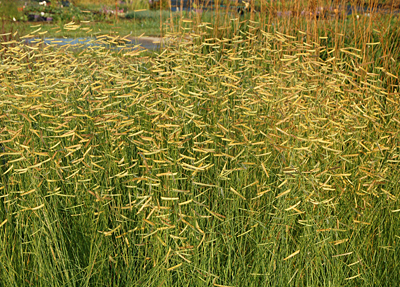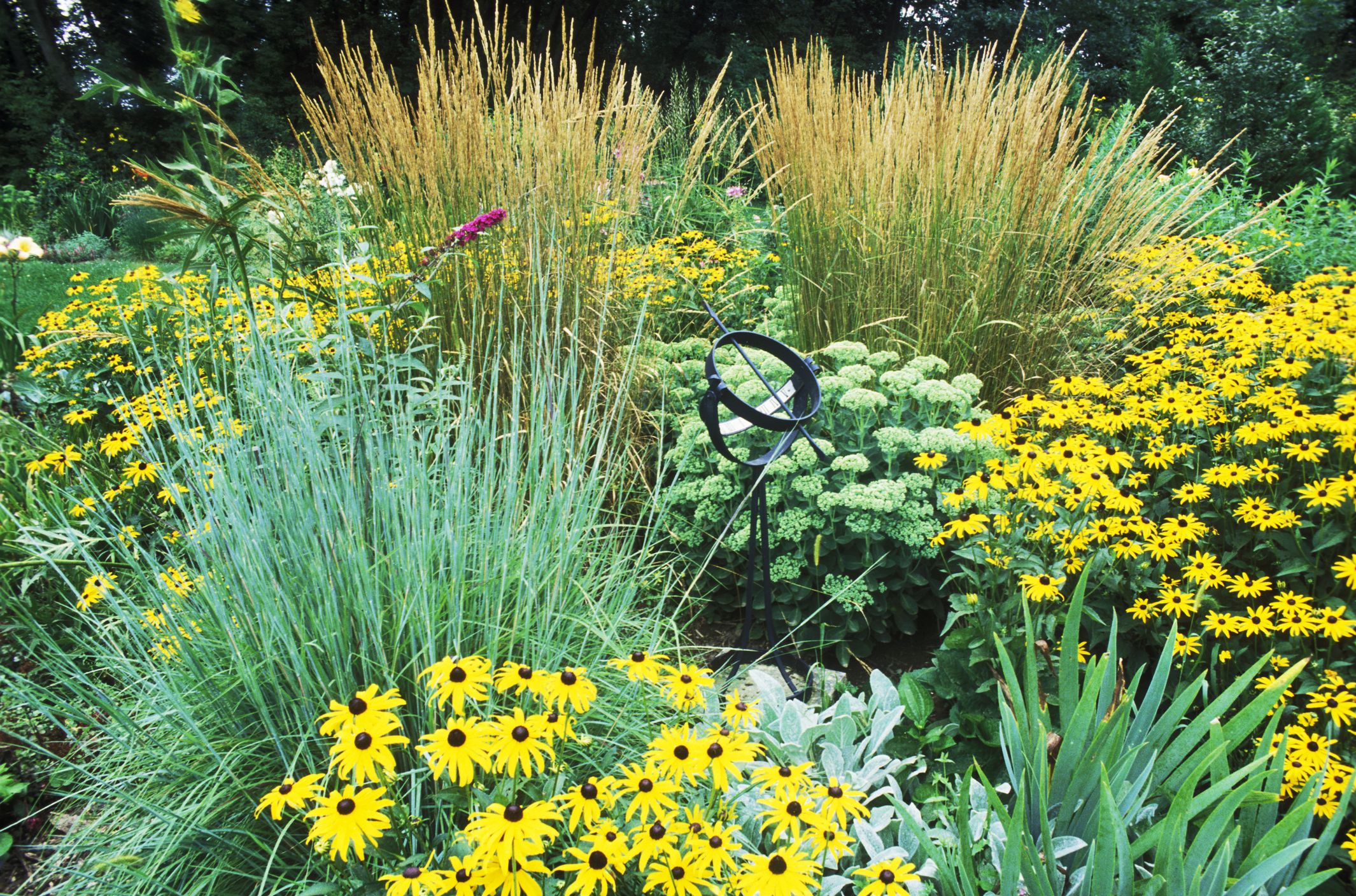
Ornamental grasses compose one of the largest groups of plants on the planet. Cool-season grasses are evergreen and hold their foliage year-round. Warm-season grasses are dormant in winter and begin growing in the spring, flowering in summer or fall. Native grasses mingle perfectly with wildflowers and play an important role in any native planting.
Bamboo
The stems of Bamboo are referred to as ‘culms’
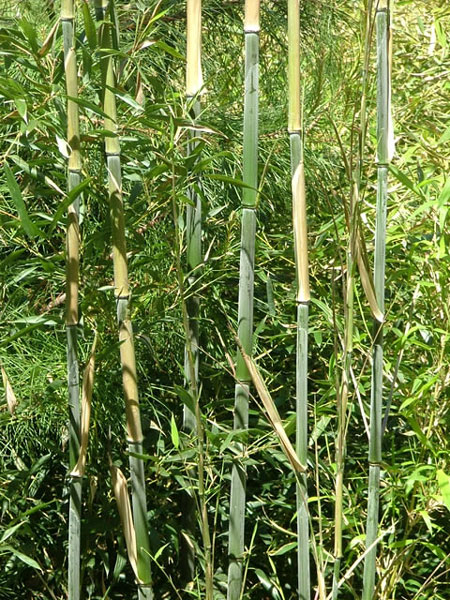
Bissett’s Running Bamboo
Phyllostachys bissettii
Height: 40′
Bissetii is a great medium height bamboo plant for a cold hardy bamboo screen. It is tolerant to most all planting sites and conditions. A very cold hardy green bamboo. Good to minus 10degrees
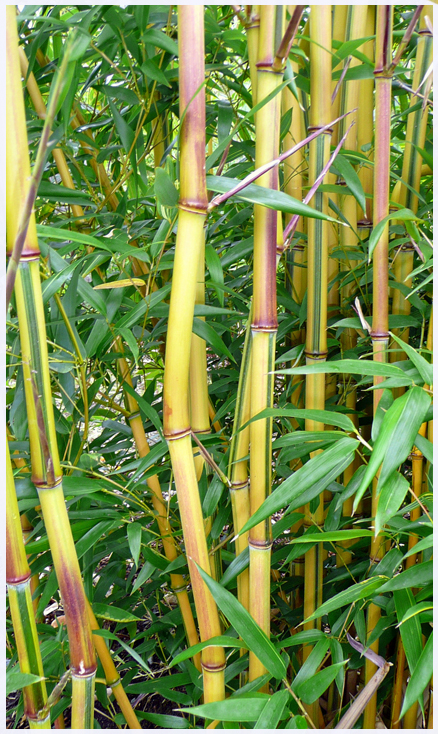
Golden Crookstem Running Bamboo
Phyllostachys aureosulcata ‘Aureocaulis’
Height: 25-30′
The culms are a beautiful lemon yellow color at the time when the new shoots reach their full height in late spring. When planted where direct sun can shine on the culms from the south and the west, they often acquire a bright magenta highlight for a short time in the spring. This is the hardiest bamboo that has yellow or golden culms. A real jewel especially in the early summer as the new stems acquire their brightest color. They have upright and narrow stature which offer good qualities for tall screens. Good to minus 10 degrees
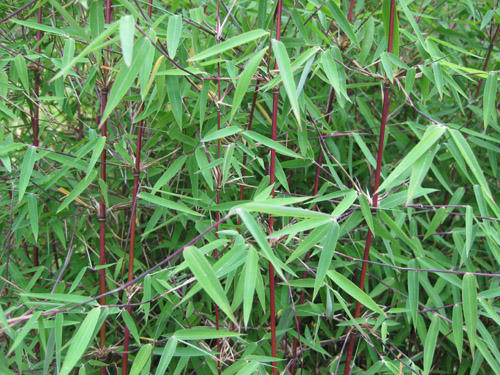
Red Dragon Clumpiing Bamboo
Fargesia jiuzhaigou ‘Red Dragon’
Height: 15′ Spread: 12′
Stunning medium-sized clumping bamboo grown for it’s colorful red culms. New culms emerge in late spring a bright green; as they mature the color changes to red and yellow. The small thin leaves are evergreen, although about 1/3 of the leaves will turn golden yellow and drop in autumn leaving an airy and feathery canopy through the winter. Red-stemmed clumping bamboo is very winter hardy and makes a great specimen in a large container. Good to minus 15 degrees
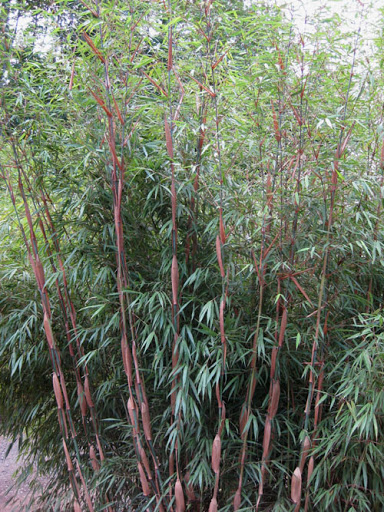
Scabrida Clumping Bamboo
Fargesia sp. ‘Scabrida’
Height: 12 – 14 ‘
The young culms have dark orange sheaths, opening gradually to reveal steel-blue and lavender culms, aging to an olive green. The leaves are dark green and slender, with a graceful, airy arrangement. Good to 0 degrees
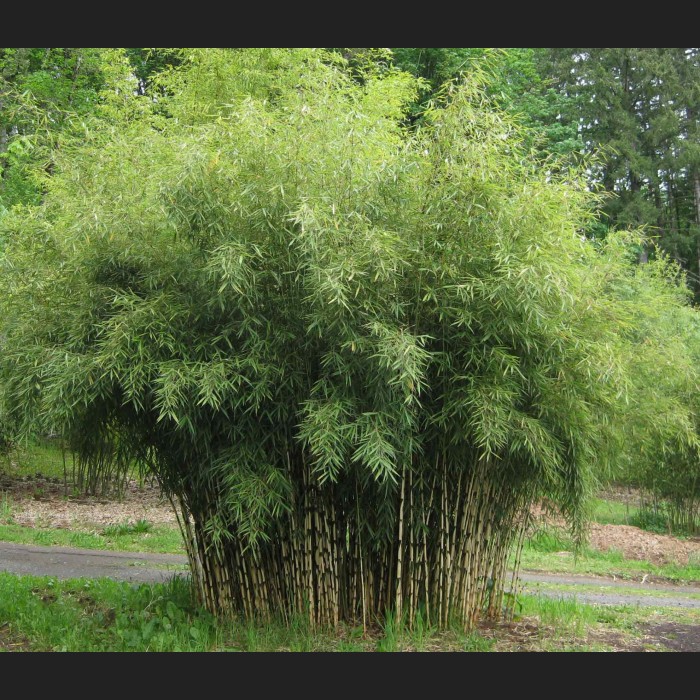
Sunset Glow Clumping Bamboo
Fargesia rufa
Height: 10′
A beautiful and very hardy bamboo with new culms that have attractive rusty reddish sheaths and a clumping root system. This new introduction is proving to be one of the most hardy and versatile clumping bamboo in the landscape. It is shorter, only about 10 feet tall when mature, but a vigorous grower, sending up many new culms each season. The new culms leaf out early in the summer, making it an excellent choice where its rapid growth is desired. Good to minus 15 degrees.
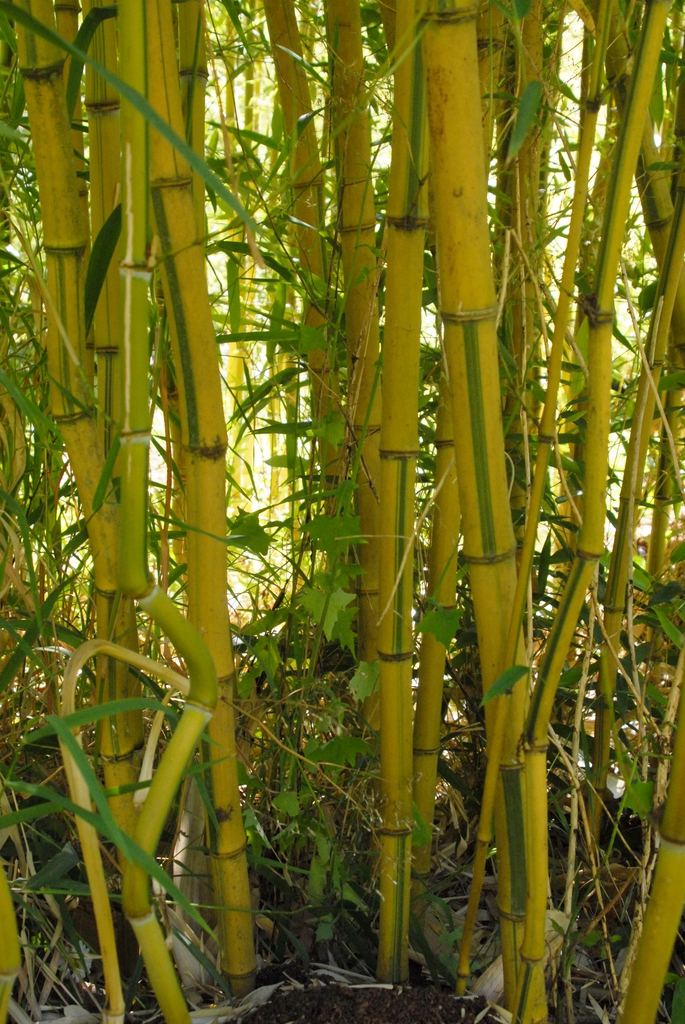
Yellow Groove Running Bamboo
Phyllostachys aureosulcata
This evergreen bamboo has slender young green culms with a pronounced yellow groove found on opposite sides of the cane. Leaves are a soft green color. A running bamboo with strong vertical growth. Full to partial sun. Fast-growing to 15 to 25 feet high.
Cool-Season Grasses
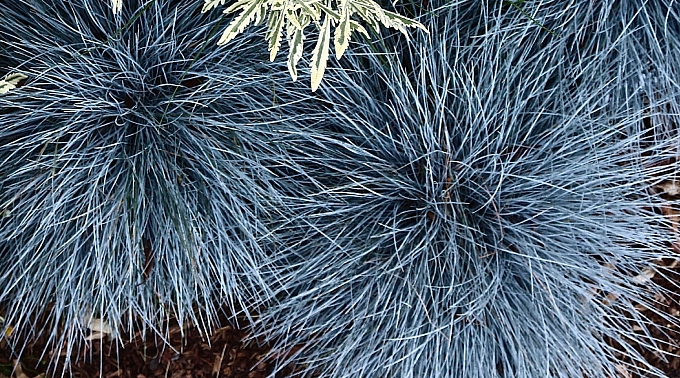
Beyond Blue Blue Fescue
Festuca glauca ‘Beyond Blue’
Height: 9-12″
One of the best Blue Fescues. Attractive feathery tan seed heads complement the blue foliage and resemble wheat. Stunning accent plant, great edger or enticing planted en masse.
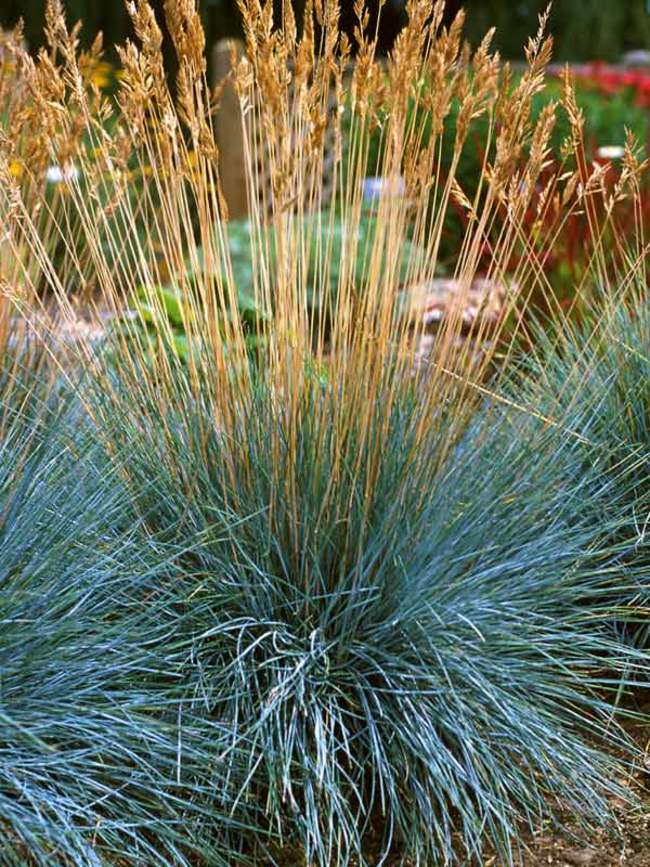
Elijah Blue Blue Fescue
Festuca glauca ‘Elijah Blue’
Soft powdery blue, spiky foliage that keeps its color all year round makes this grass a top pick. One of the more durable and longer-lived varieties, ‘Elijah Blue’ is a small, clumping grass with a rounded habit. In early summer, wheat-like seed heads are produced on tall, spikey stalks in great numbers. Preferring dryer conditions, this is the perfect grass for rock gardens, in stone troughs or pots, for costal climates, or even for use as edging.
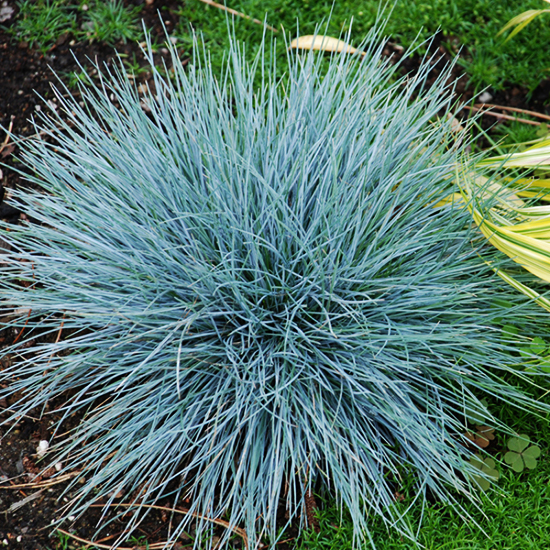
Boulder Blue Blue Fescue
Festuca glauca ‘Boulder Blue’
Height: 6-10″
Intensely blue and slightly more compact with a tighter habit than Elijah Blue. Festuca Boulder Blue blooms heavily with upright flower stalks producing tan seed plumes that rise just above the tufts. Pair with lower growing sedums for a low maintenance groundcover.
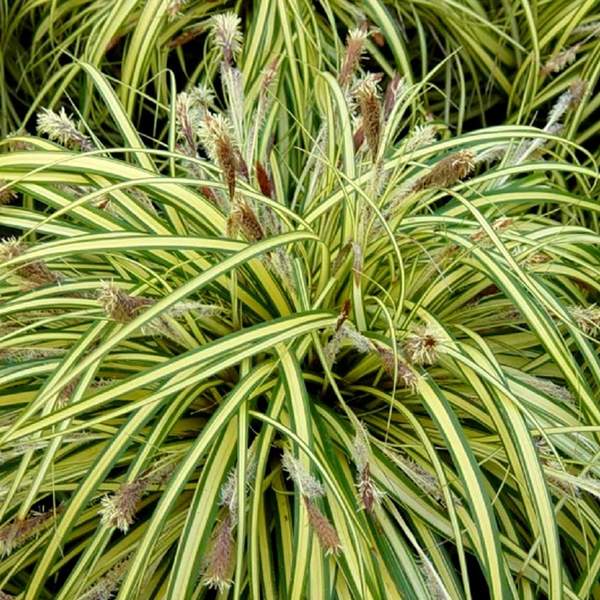
Evergold weeping Sedge
Carex oshimensis ‘Evergold’
Height: 10-16″
Brightly variegated foliage in yellow and green of Carex Evergold features a tight fountain-like habit, even in the shade. Try planting with Astilbe and Fern to provide a contrast in textures. Maintains a good appearance in summer and winter.
Warm Season Grasses
Feather Reed Grass
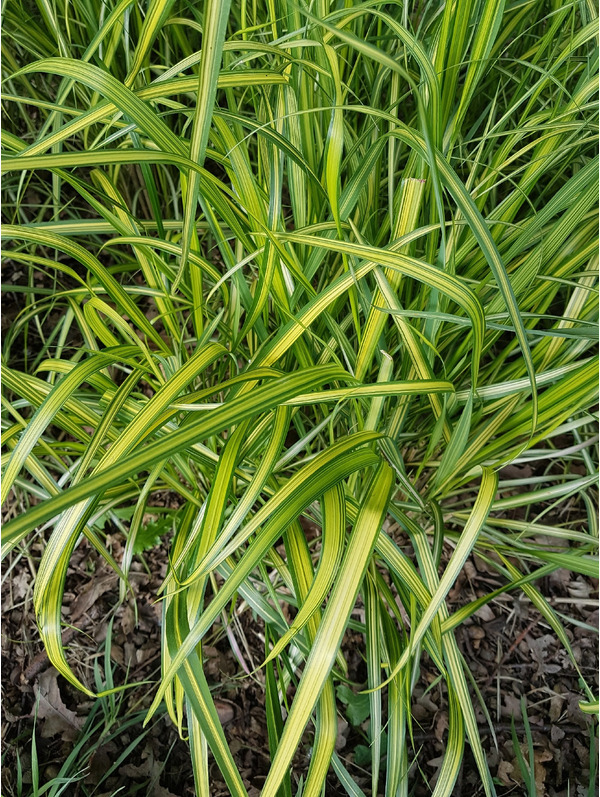
El Dorado Feather Reed Grass
Calamagrostis x acutiflora ‘El Dorado’
This variety is almost identical in shape, but ‘Eldorado’ has golden-yellow midribs. It’s seed heads have a golden yellow hue. It grows upright in stiff clumps that keep their shape through the year. They grow only to 5 or 6 feet tall, making them one of the most manageable ornamental grasses for the home landscape.
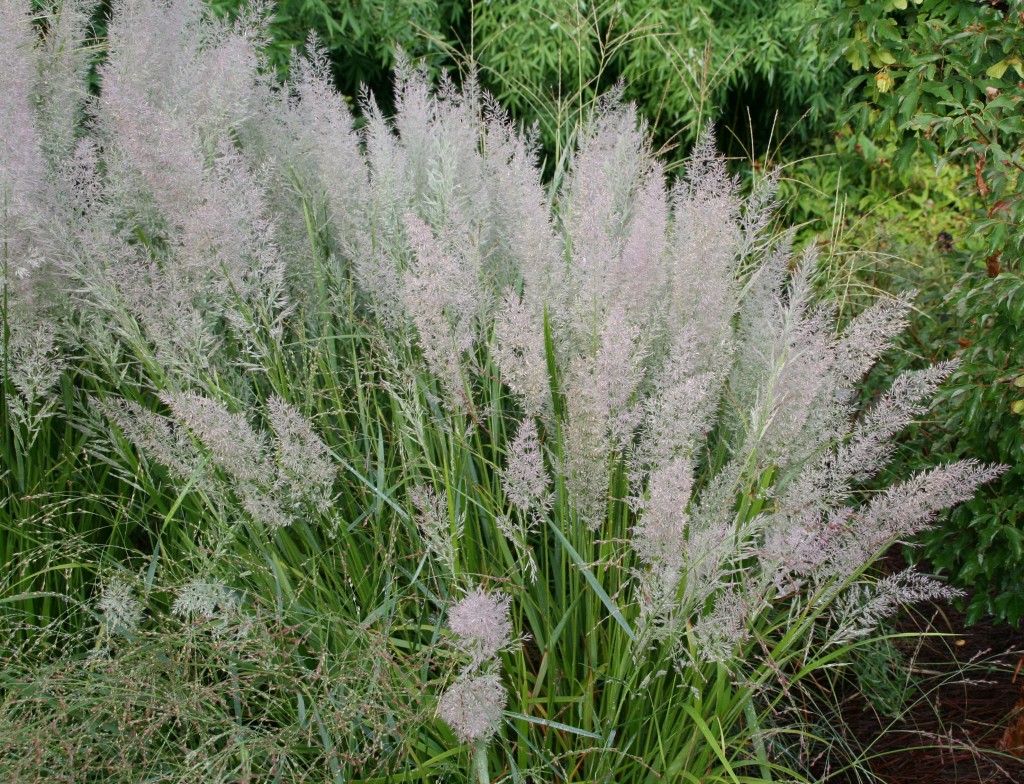
Korean Feather Reed Grass
Calamagrostis brachytricha
A species of reed grass, is a slowly-spreading, clump-forming, warm season ornamental grass which features a mound of narrow, stiff, green leaves (1/4 to 5/8″ wide) typically growing to 2′ tall and as wide. Pinkish tinged flower plumes appear in late summer atop stems rising well above the foliage clump to 4′ tall. Plumes mature to a light tan as the seeds ripen, but tend to disintegrate by early winter.
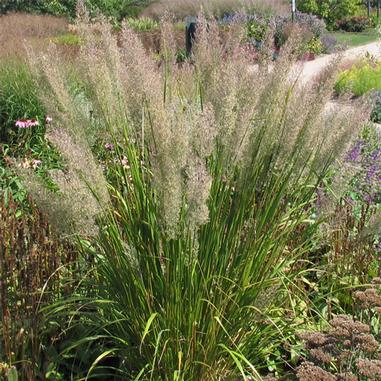
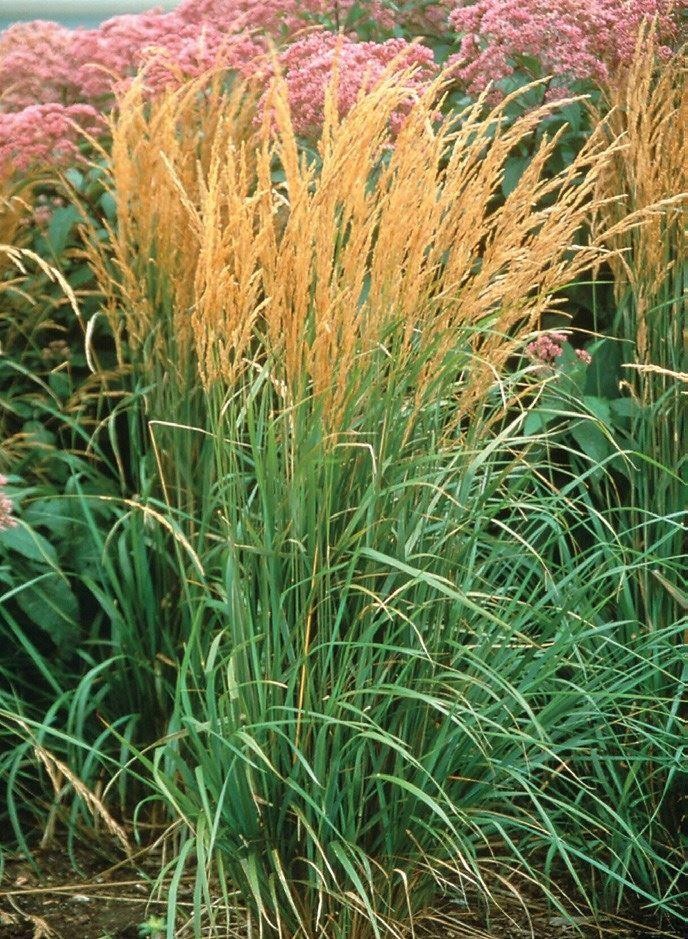
Karl Foerster Feather Reed Grass
Clamagrostis x acutiflora ‘Karl Foerester’
The first ornamental grass to receive the Perennial Plant of the Year Award® (2001), earned for good looks, long-lasting plumes and undemanding growing requirements. Green foliage grows in a neat, 2-foot clump. In early spring, stalks rise up to 6 feet, capped with elongated, wheat-colored seed heads. Exhibits tolerance for heavy clay and compacted soil and will not reseed (seeds are believed to be sterile). Plant in sunny, dry locations and use as a backdrop for flowering perennials.
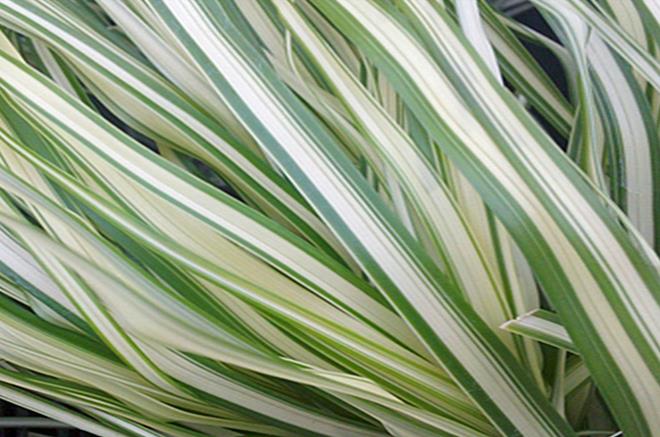
Lightning Strike Feather Reed Grass
Calamagrostis x acutifolia ‘Lightning Strike’
This grass has a mounding upright habit. Leaf blades have a bold white central stripe and green edge. Sterile flower plumes emerge green, changing to pink and purple, then maturing a golden-tan. Foliage and flowers dry and persist through the fall and winter.
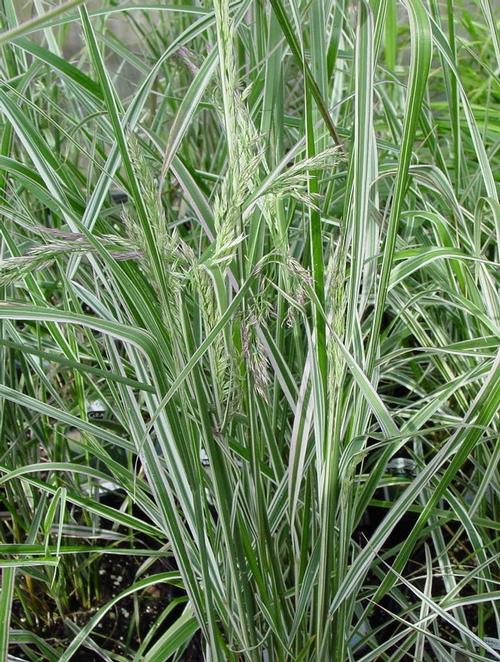
Overdam Feather Reed Grass
Calamagrostis x acutiflora ‘Overdam’
A feather reed grass cultivar which is noted for having variegated foliage featuring green leaves with creamy white margins. It is further distinguished by having a more compact size (2-4’ tall) and for its pinkish-green flowers.
Fountain Grass
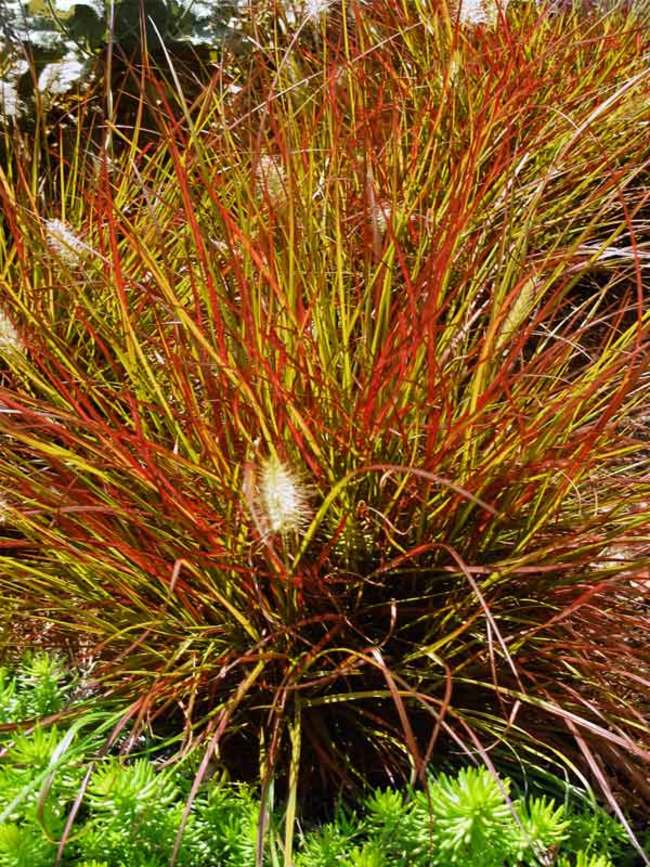
Burgundy Bunny Dwarf Fountain Grass
Pennisetum alopecuroides’ Burgundy Bunny’
A red-tinted sport of P. Little Bunny. The upright mounding narrow foliage is highlighted with red in summer, but by fall is ablaze with intense burgundy. Bunny tail cream-colored plumes heighten the appeal of this charming miniature.
Pennisetum are prized for their arching multitude of bottle-brush plumes. P. Burgundy Bunny is appealing in containers. Lovely when mass planted in the front of the border.
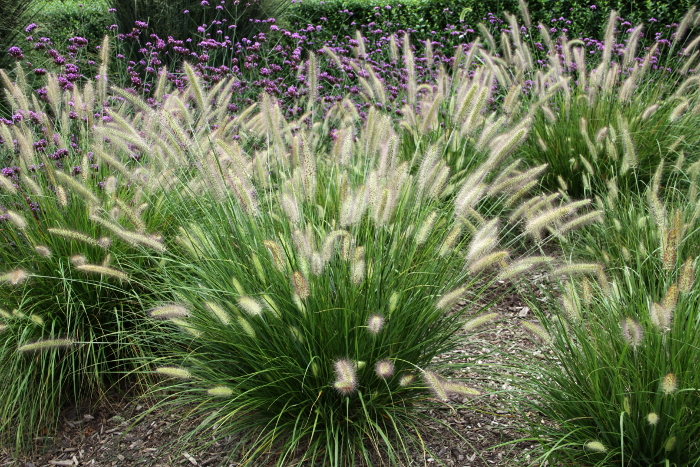
Hameln Dwarf Fountain Grass
Pennisetum alopecuroides ‘Hameln’
‘Hameln’ Fountain Grass is a smaller variety with three distinctive seasons of stunning displays in full sun or part shade gardens. First, fine-textured green grass blades up to 3 feet tall are tipped with soft, bottle-brush-like flower. Foliage turns rust gold in autumn, and finally, pale blonde in winter. ‘Hameln’ is a favorite for birds and resists hungry deer. A great match for late-season perennials and colorful shrubs in the mixed border, as well as cut or dried flower arrangements.
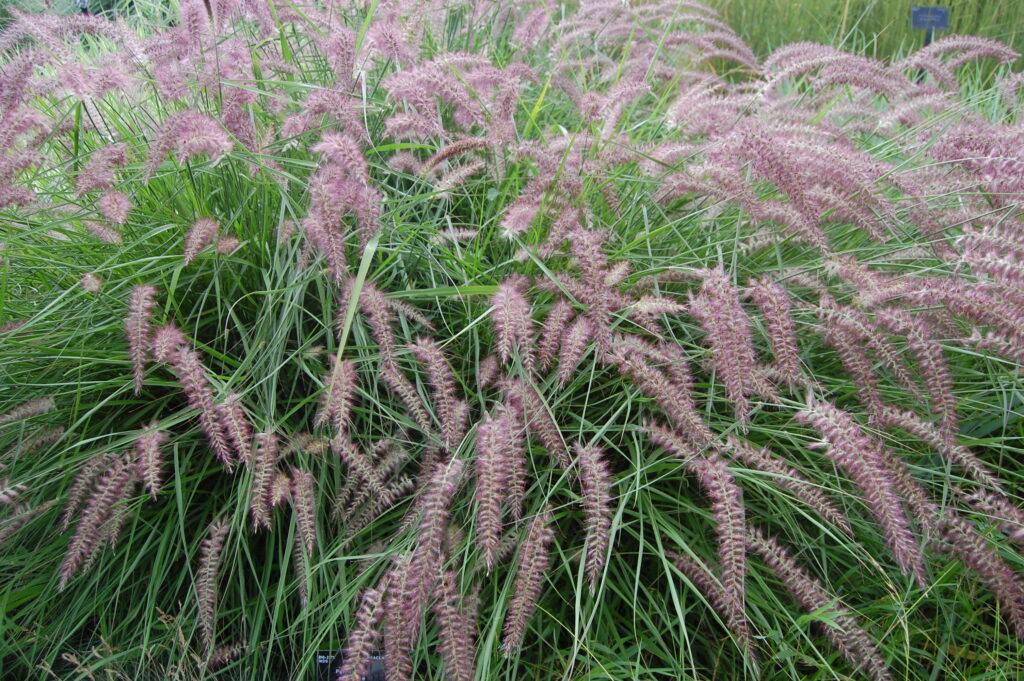
Karley Rose Fountain Grass
Pennisetum orientale ‘Karley Rose’
Height: 36-42″ Spread: 36″
‘Karley Rose’ is an outstanding selection of fountain grass enjoyed for its showy, dark, rose-purple flower spikes that cover the plant from mid-summer into early fall. Improved vigor, size, darker flowers and cold hardiness distinguish this variety from other fountain grasses.
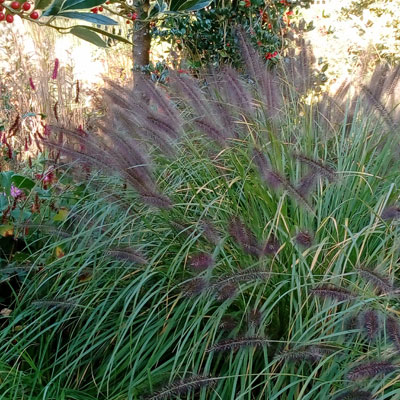
Moudry Fountain Grass
Pennisetum alopecuroides ‘Moudry’
Height: 2′ Spread: 2′
Flowing with fairly wide, glossy deep green foliage, ‘Moudry’ forms a burnished, tidy-looking basal mound. The captivating bushy spikes resemble large dense foxtails, as they rise on stiff stalks just above lush deciduous leaves, which color to yellow and orange come autumn. Second-to-none among ornamental grasses, the fuzzy blooms impart dark purple-black shades, and make phenomenal cut flowers, fresh or dried.
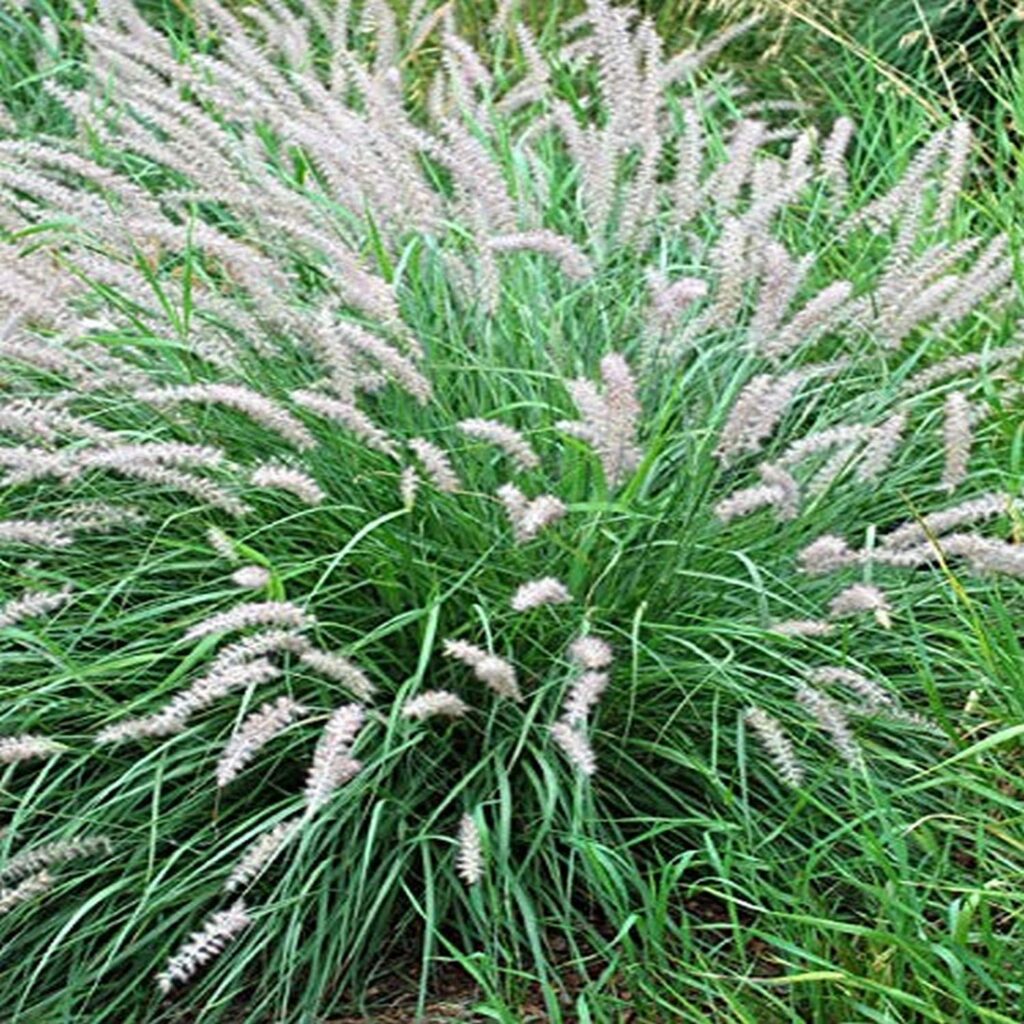
Oriental Fountain Grass
Pennisetum orientale
A warm season fountain grass that is native to Asia. It is an ornamental grass that typically forms graceful, spreading foliage clumps to 18” tall and as wide of narrow, gray-green leaves (to 1/4” wide). Showy, fluffy, pinkish-white flower spikes arch upward and outward from the foliage clump in late summer like water spraying from a fountain, hence the common name. Flower spikes rise well above the foliage to 2.5-3’ tall. Flower spikes persist over a very long bloom period from early June to August before eventually disintegrating. Foliage changes to yellowish-tan in fall, and usually remain attractive throughout the winter.
Japanese Forest Grass
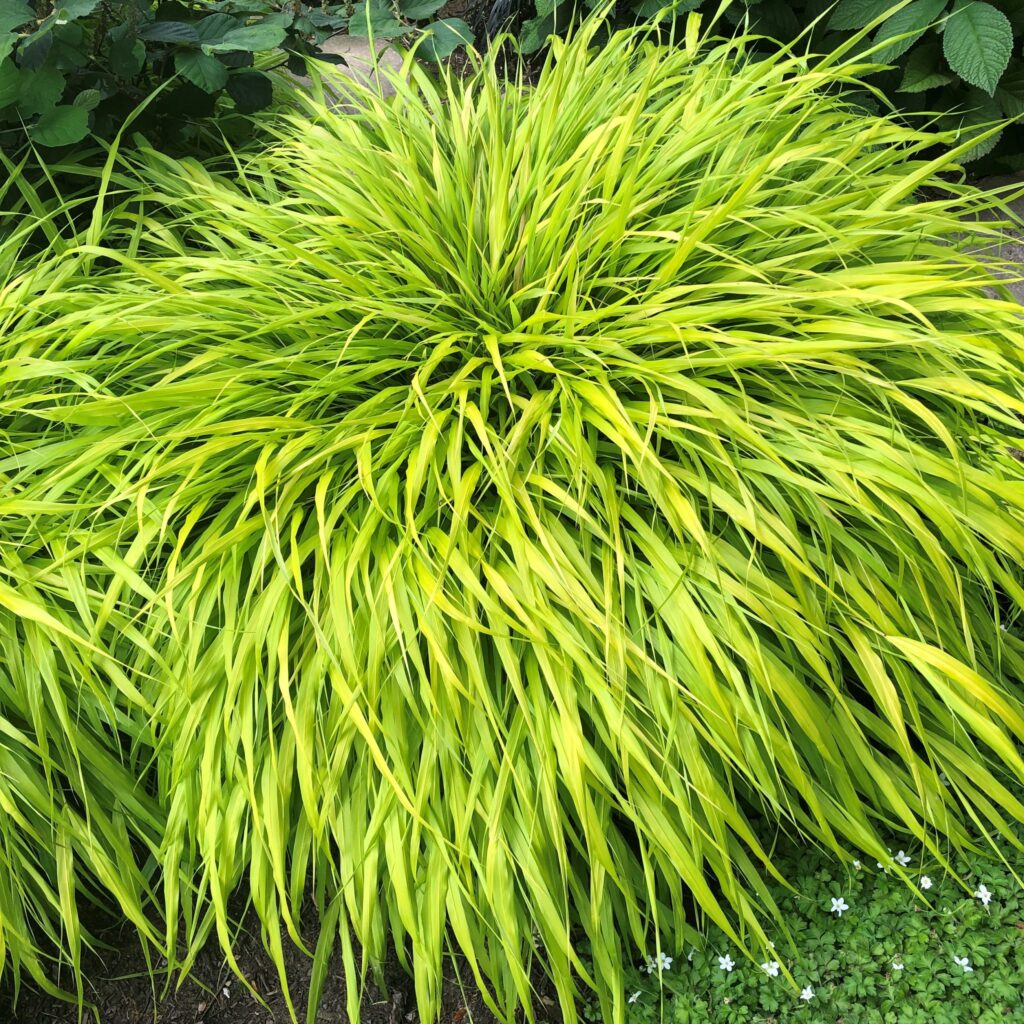
All Gold Hakone Grass
Hakonechloa macra ‘All Gold’
Height: 10″ -2′ Spread: 1-2′
2009 Perennial Plant Association’s Plant of the Year. ‘All Gold’ has glowing golden-yellow foliage bringing a brighter presence into the shade garden. A bit more upright than the species but will still gently cascade in the distinctive Hakone grass habit. Will take on a more chartreuse coloring in full shade. Hakone grass does produce seed heads. Tiny, inconspicuous flower spikelets appear in airy clusters from late summer thru early fall.
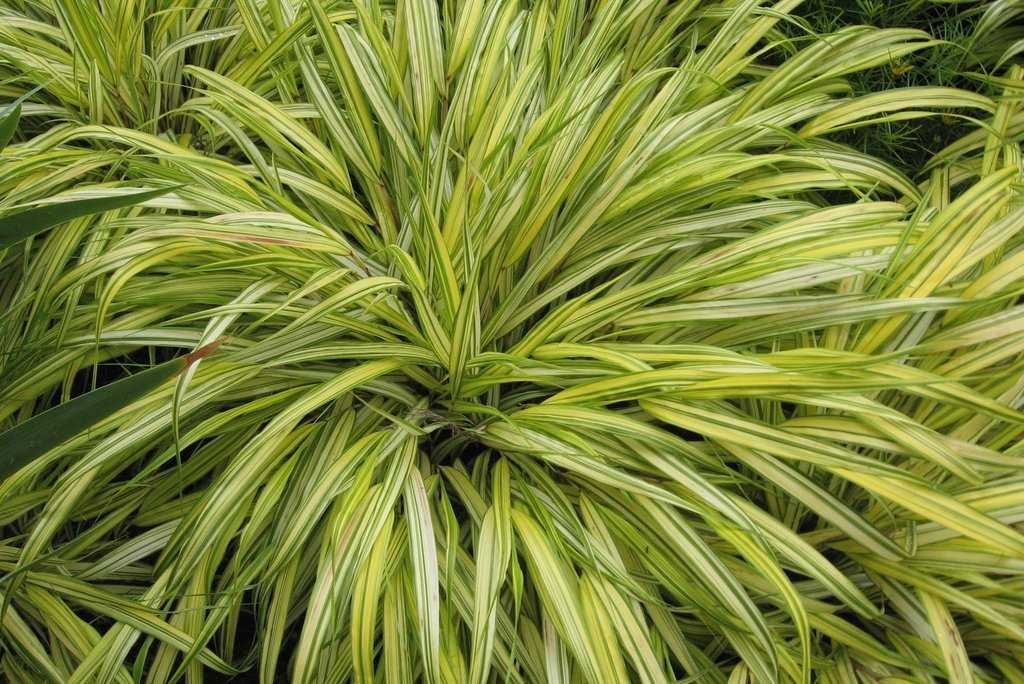
Aureola Hakone Grass
Hakonechloa macra ‘Aureola’
Height: 1.5′ Spread: 1.5′
Variegated but nearly all yellow, the leaf blades have narrow green stripes, mostly near the margins. Though this grass does spread by rhizomes, it is a slow grower and will not rapidly overtake its neighbors. When grown in part shade, the yellow tones in the leaves will be most pronounced. In deep shade, the variegation will be lime green.
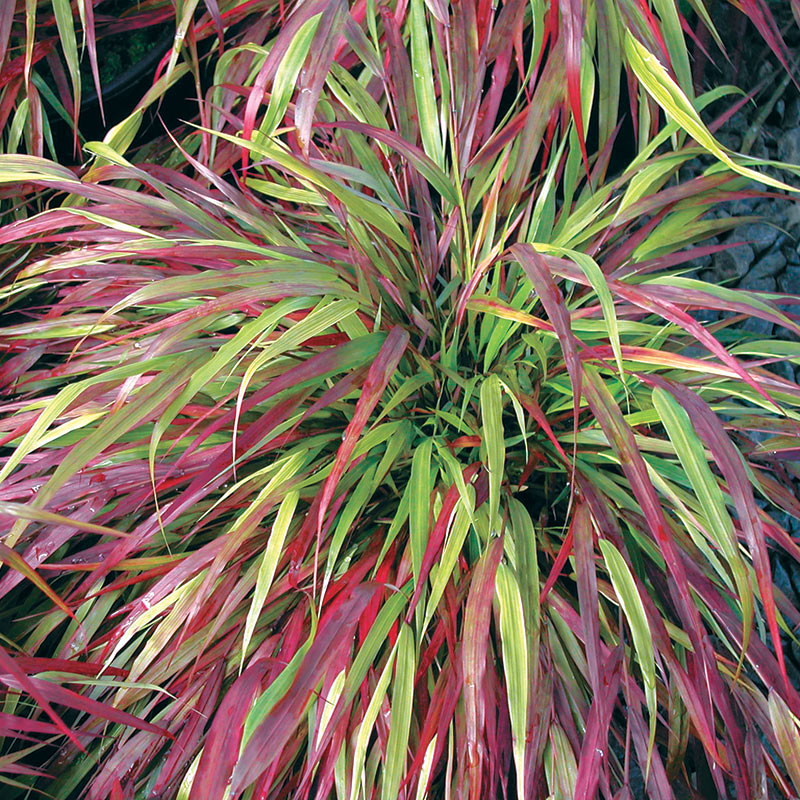
Beni Kaze Hakone Grass
Hakonechloa macra ‘Beni Kaze’
Height: 2′ Spread 4′
This Japanese forest grass slowly matures into a soft flowing mound. The thin rich green blades will start to develop red on the tips in late summer and gradually gain more red through the fall. In full fall color this grass is a bright blend of deep red, burnt orange and deep gold. The billowy form moves with the slightest breeze and is a great for adding movement to the garden.
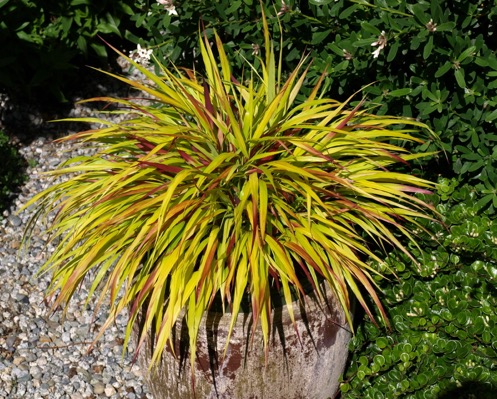
Sunflare Hakone Grass
Hakonechloa macra ‘Sunflare’
Height: 12-18″ Spread: 18-24″
A vigorous selection with vibrant chartreuse leaves becoming intense golden yellow with more sun; randomly highlighted in deep crimson. More mature, 2 year+ old plants, will show increasingly better crimson highlights. Fall coloring is a combination of chartreuse and gold saturated with tones of burnt orange and burgundy-red. Neat, compact mounding habit with graceful cascading foliage; increases slowly by way of dense rhizomes.
Maiden Grass
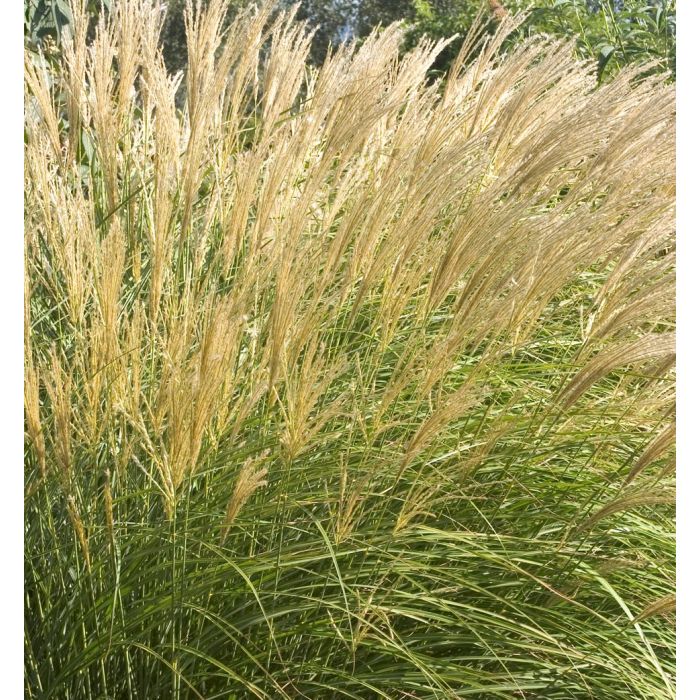
Adagio Maiden Grass
Miscanthus sinensis ‘Adagio’
Dwarf, typically growing 3 to 4 feet tall (5 feet in bloom.) It is an upright, warm season, clump-forming ornamental grass which features extremely narrow, silver-gray blades which turn yellow in fall. Tiny pink-tinged flowers appear in tassel-like inflorescences above the foliage in late summer, gradually turning into creamy white plumes by fall as the seeds mature. Foliage and flower plumes persist well into winter providing good winter interest.
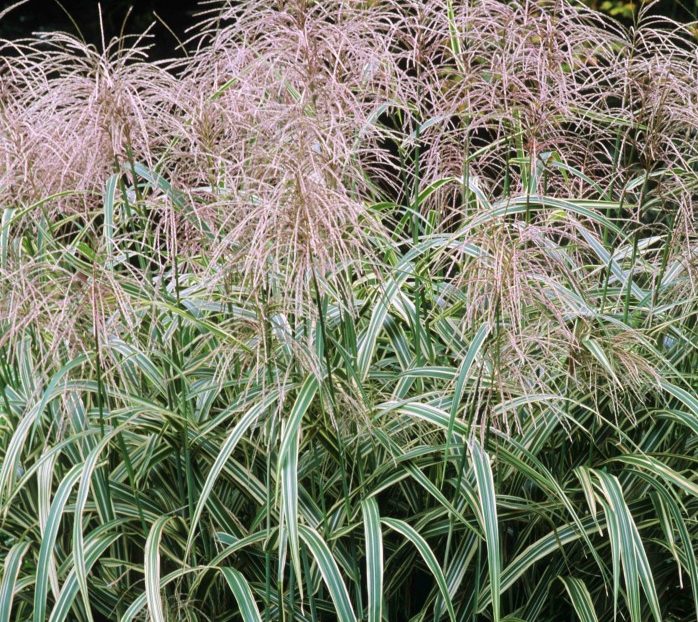
Cosmopolitan Maiden Grass
Miscanthus sinensis ‘Cosmopolitan’
Noted for its wide leaves with a creamy margin and a broad green midrib which form a substantial, arching clump; individual stems may revert to solid green. Flower plumes persist well into winter providing good winter interest. Tolerates sandy soils but will need regular summer watering.
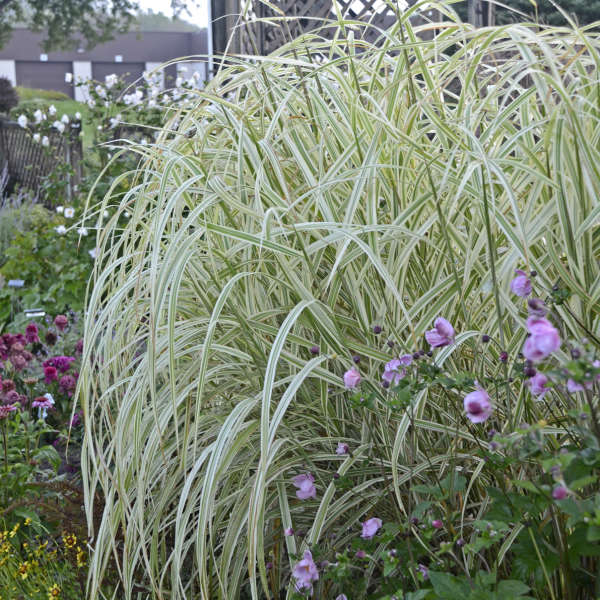
Dixieland Maiden Grass
Miscanthus sinensis ‘Dixieland’
A dwarf form of ‘Variegatus’ with very similar green and white variegated foliage but a shorter, more compact growth habit. This selection should not need staking like its taller cousin. It provides a strong white element to the landscape which is especially pronounced when planted in front of larger shrubs or evergreens. The silky pink plumes which appear in late summer are very showy. A good choice for containers.
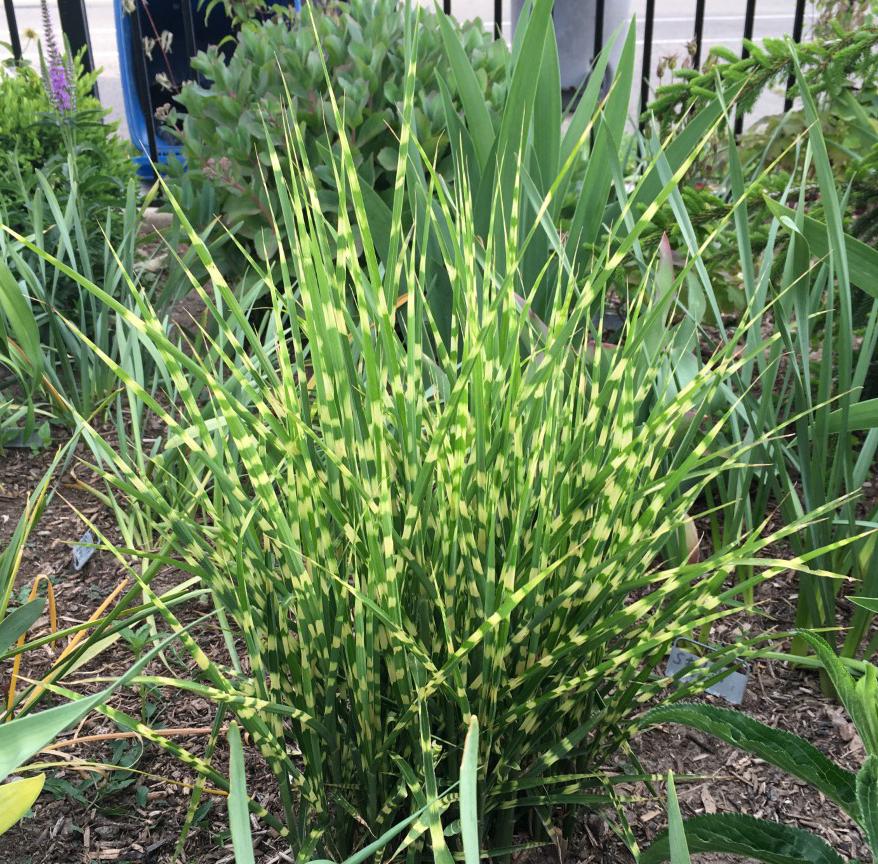
Gold Bar Maiden Grass
Miscanthus sinensis ‘Gold Bar’
Variegation appears as ‘bands’ across the blade, rather than lengthwise, giving a dappled shimmery appearance from a distance. Strong stems retain the shape of the clump even in wind. Plumes emerge burgundy-red maturing to beige.
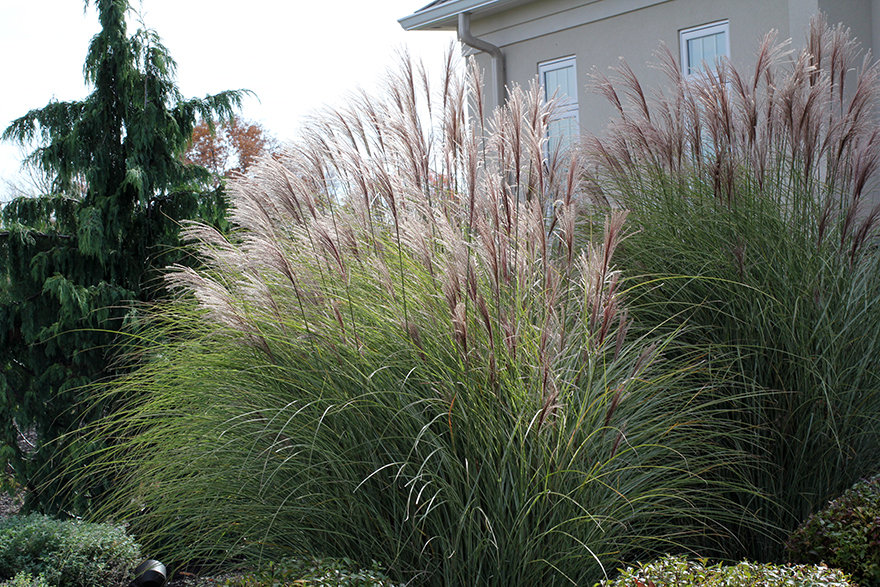
Gracillimus Maiden Grass
Miscanthus sinensis ‘Gracillimus’
Noted for its narrow green leaves with a silver midrib which form a substantial, rounded, arching clump of foliage typically growing 4-6′ tall (to 8′ when in flower). Foliage turns yellowish after frost, but quickly fades to straw-beige by winter. Tiny reddish-copper flowers appear in tassel-like inflorescences above the foliage in late September, gradually turning into silvery white plumes as the seeds mature. Blooms later with flower plumes persisting well into winter providing good winter interest. ‘Gracillimus’ is an old and very popular cultivar.
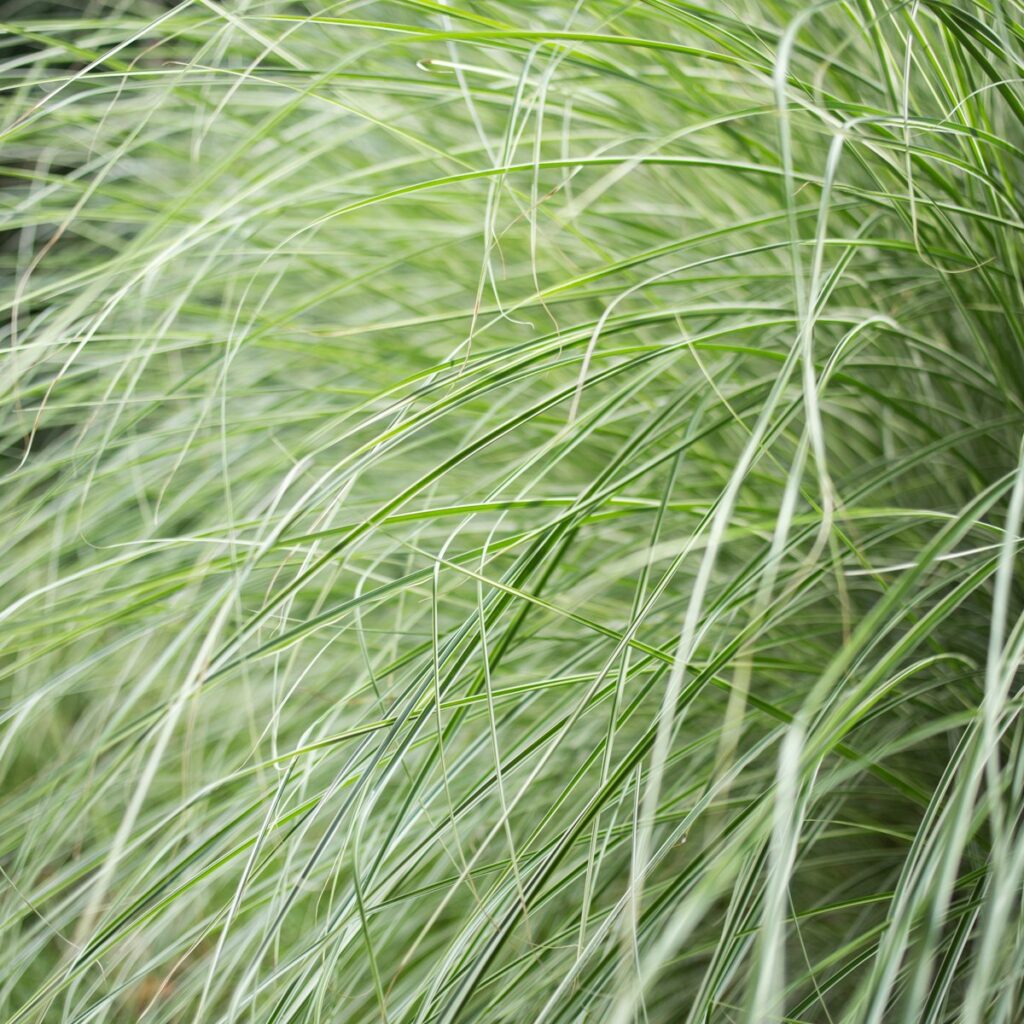
Morning Light Maiden Grass
Miscanthus sinensis ‘Morning Light’
Very narrow green leaves with white variegation on the margins gives this grass an overall silvery appearance. Typically forms an upright, rounded clump of foliage growing 4-6′ tall. Tiny reddish-copper flowers appear in long tassel-like inflorescences above the foliage in mid to late September, gradually turning into silvery white plumes as the seeds mature. ‘Morning Light’ is a somewhat smaller, more fine-textured version of the popular M. s. ‘Gracillimus’.
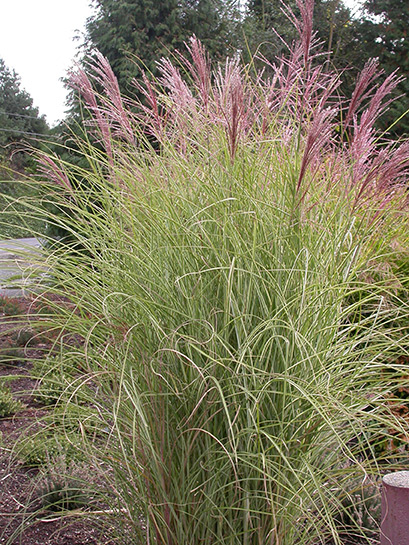
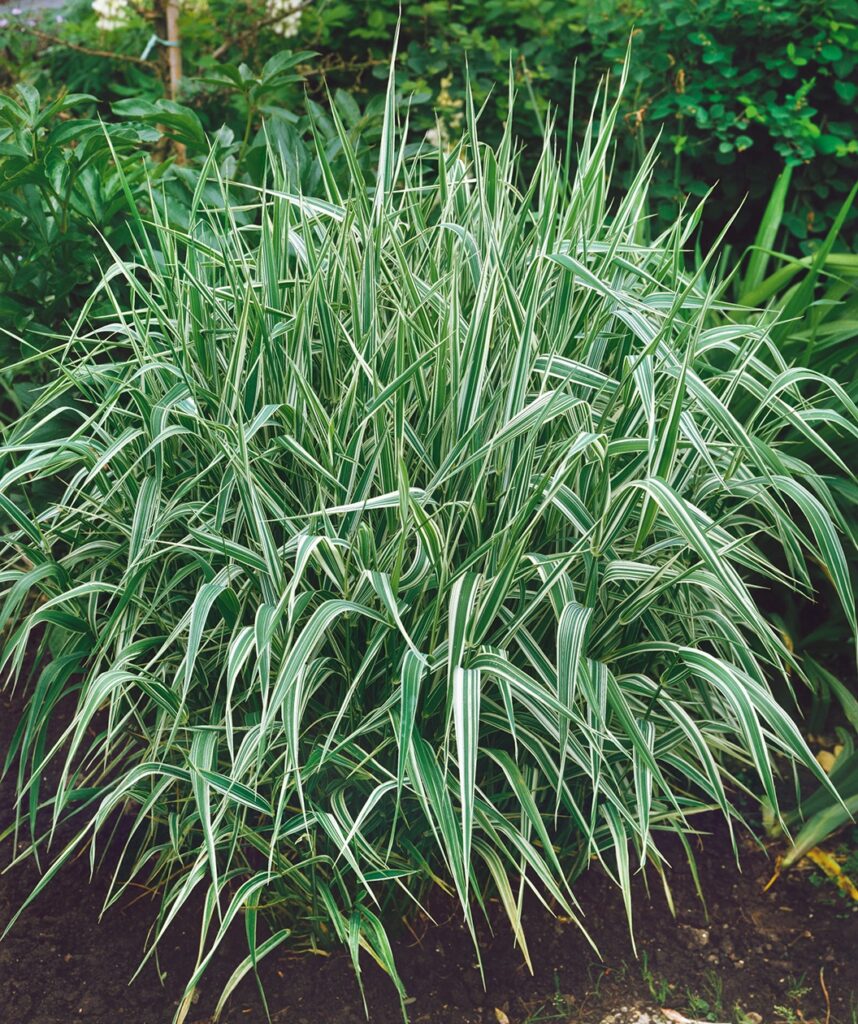
Variegated Maiden Grass
Miscanthus sinensis ‘Variegatus’ (aka ‘Yakushima’)
A variegated Maiden grass cultivar which typically grows in an arching, rounded clump to 5-6′ tall (flower plumes can increase height to as much as 7- 9′ tall). Features leaf blades variegated with green and white stripes, with white being the predominant color from a distance. Foliage fades to tan after frost. Tiny reddish flowers appear in tassel-like inflorescences which rise above the foliage clump in September, gradually turning into silvery plumes in fall as the seeds mature. Plumes persist well into winter providing good winter interest.
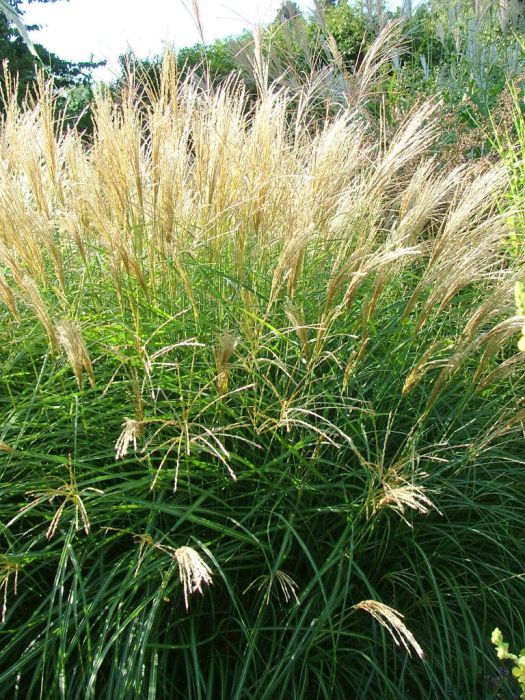
Yaku Jima Maiden Grass
Miscanthus sinensis ‘Yaku Jima’
A clump-forming dwarf form of ‘Gracillimus’ that is native to certain areas of Japan including the Island of Yaku Jima. It typically grows in a clump to 3-4’ tall. Leaf blades (to 3/8” wide) are green and arch gracefully downward. Tiny buffy colored flowers with red tinges emerge in fluffy panicles above the foliage in August-September. Panicles fade to silver in fall, but remain showy throughout winter. Foliage turns reddish-brown in fall fading to tan over winter.
Pampas Grass
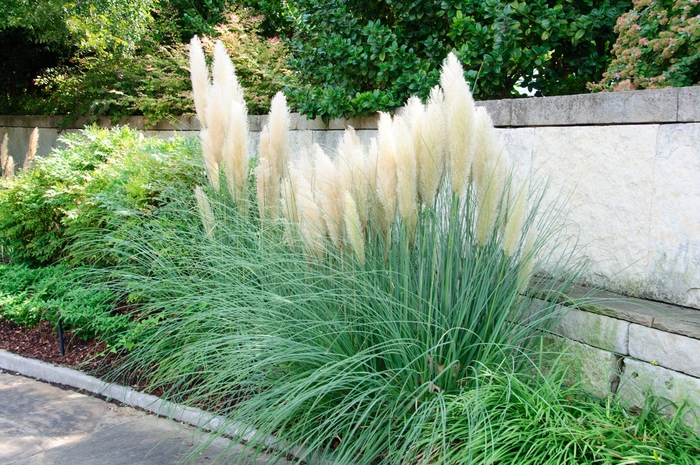
Dwarf Pampas Grass
Cortaderia selloana ‘Pumila’
Height: 4-5′ Spread: 3-4′
One of the most cold hardy varieties of pampas grass, this selection is shorter and more compact than the others. However, it bears the same showy, medium-sized plumes which are silvery-cream and feel silky to the touch. They are perfect for use in dried arrangements.
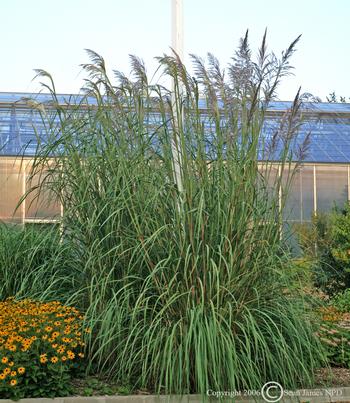
Hardy Pampas Grass
Erianthus ravennae
Having an upright arching form, the gray-green leaves reach a height of about 5 feet. In late summer, dynamic flower spikes reach skyward, achieving impressive heights of 8 to 12 feet. Silvery flower panicles with hints of purple top these spikes and then brighten to white in fall. These plumes are often used in fresh and dried flower arrangements.
Switch Grass
Missouri native ornamental grass which was an important component of the tallgrass prairie which once covered large areas of the State. It occurs in both wet and dry soils in prairies and open woods, gravel bars and stream banks and along railroad tracks throughout most of the State.
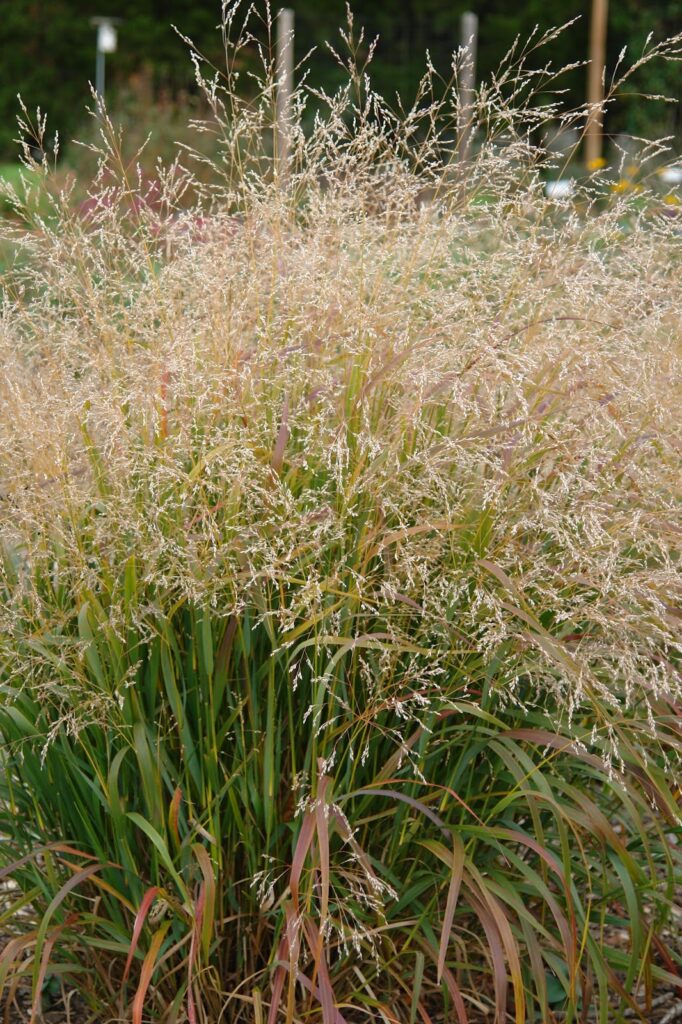
Cape Breeze Switch Grass
Panicum virgatum ‘Cape Breeze’ PP24895
A compact Switchgrass that shares the toughness and adaptability of Switchgrass cultivars while offering distinct outstanding traits. It’s short and upright; it’s salt tolerant, and it blooms earlier in the season and stays green later into fall than other Switchgrasses. The short, dense, habit makes it valuable for smaller areas and containers.
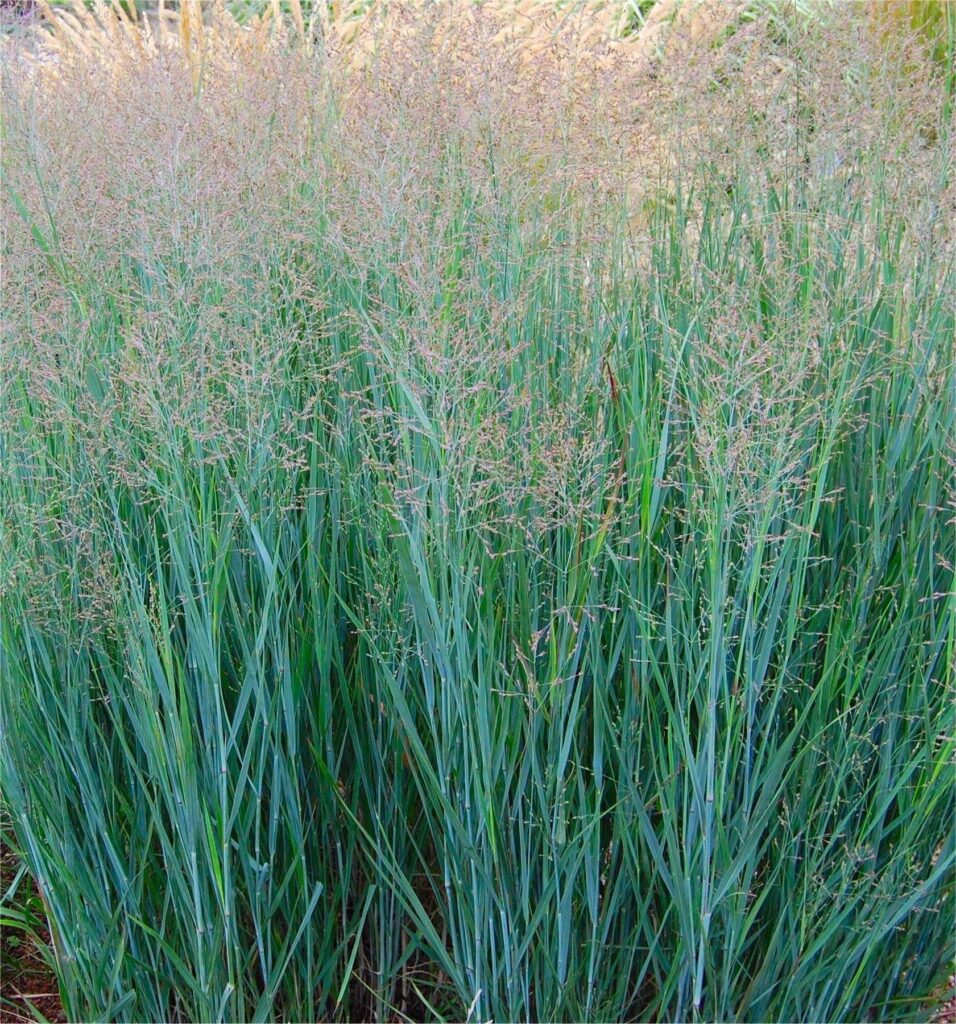
Heavy Metal Switch Grass
Panicum virgatum ‘Heavy Metal’
‘Heavy Metal’ features metallic-blue foliage and a columnar form to 3′ tall (to 5′ when in flower). Features metallic-blue leaves which turn yellow in autumn, fading to tan-beige in winter. Foliage clump is topped in mid-summer by finely-textured, pink-tinged, branched flower panicles which hover over the foliage like an airy cloud. Panicles turn beige as the seeds mature in fall with the seed plumes persisting well into winter. Seeds are a food source for birds in winter.
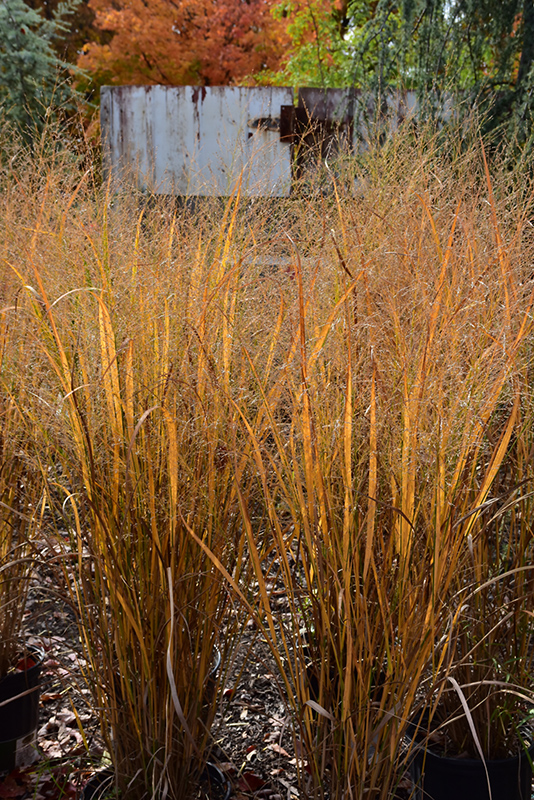
Northwind Switch Grass
Panicum virgatum ‘Northwind’
One of the best vertical forms of any of the many panicum cultivars currently available. Olive-green to bluish-green foliage forms a compact, narrow, erect, 4-5′ tall clump. Foliage turns yellow-beige in fall and provides good winter interest.
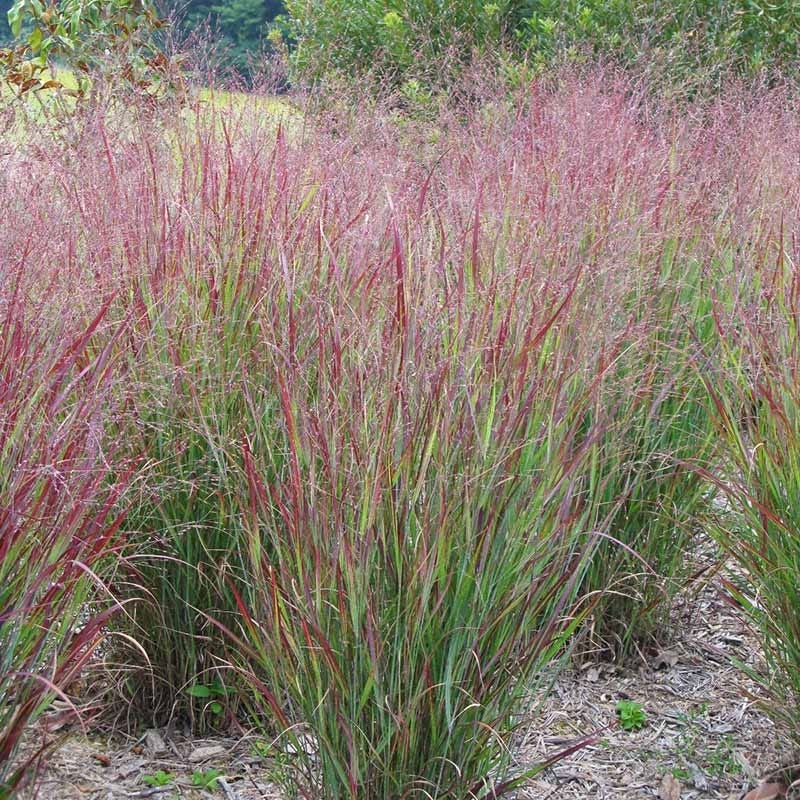
Shenandoah Switch Grass
Panicum virgatum ‘Shenandoah’
‘Shenandoah’ features some of the best burgundy-red foliage of the many panicum cultivars currently available. Foliage emerges bluish-green but rapidly turns burgundy-red (by late June) to form a compact, narrow, erect, 3′ tall clump of foliage which is topped in summer by finely-textured, reddish-pink flower panicles which hover over the foliage like an airy cloud.
Native Grasses
Bluestem
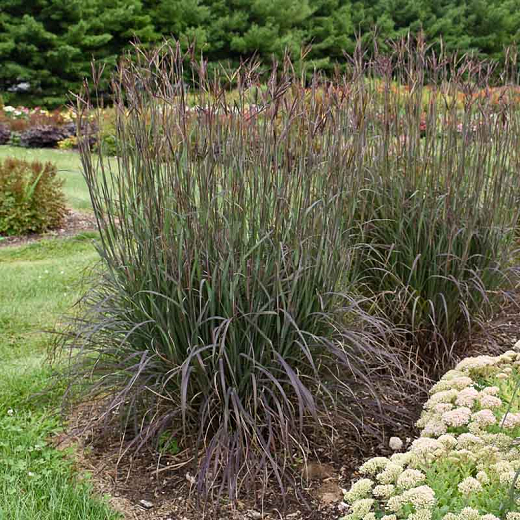
Blackhawks Big Bluestem
Andropogon gerardii ‘Blackhawks’
Big Bluestem are perfect for providing height and color to the garden, coming into prime a little earlier than other ornamental grasses. The foliage emerges deep green to dark purple in spring and deepens to near black by fall. Dubbed the “monarch of the prairie”, this native grass was once the dominant component of the American tallgrass prairie. It adapts easily to a wide range of soil and moisture conditions as long as full sun is provided. This long-lived grass has a variety of uses including screening, naturalizing, restoring prairies, and nesting materials for birds and mammals
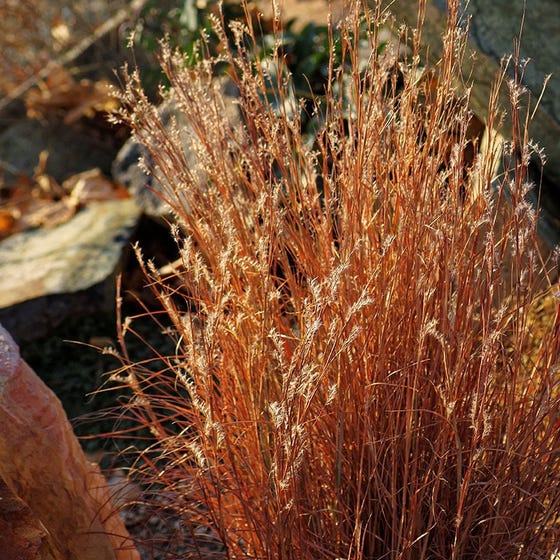
Blaze Little Bluestem
Schizachyrium scoparium ‘Blaze’
A cultivar that is noted for its vivid red fall foliage. It typically grows in an erect, broom-like clump to 2-3’ tall. Slender, flat, leaves emerge light blue in spring, darken to gray-green in summer, acquire purple highlights in late summer before exploding into a blaze of fall color consisting of intense shades of pinkish-orange to reddish-purple to vivid red. Foliage typically retains some color throughout winter. In July-August, flower stems rise higher than the foliage clump bearing small reddish-brown flowers. Flowers give way to seed heads fringed with showy, silvery-white hairs. Seed heads may persist into winter.
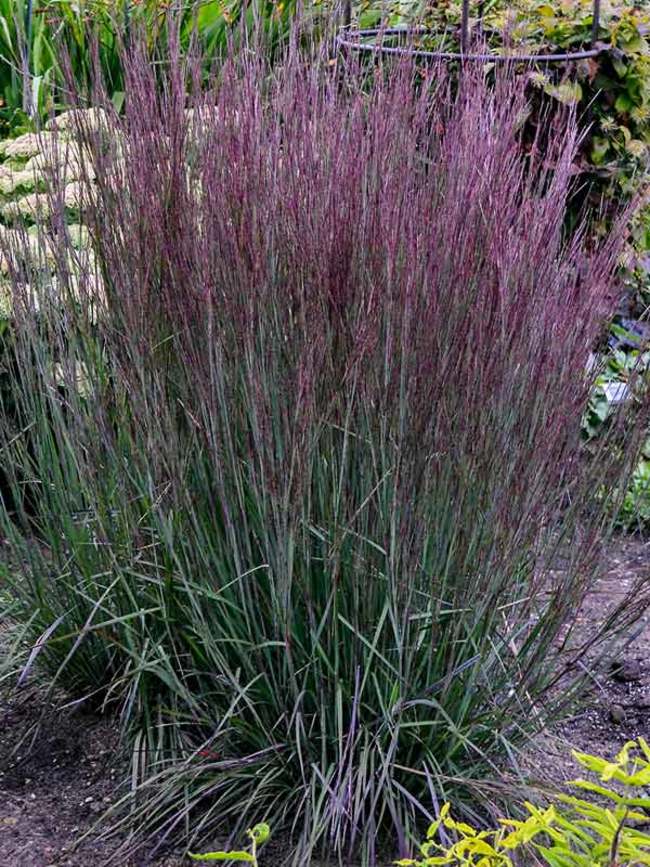
Blue Paradise Little Bluestem
Schizachyrium scoparium ‘PRAIRIE WINDS® Blue Paradise’
The habit is very upright and columnar, and maintains its upright habit through fall. At 3½’ tall, this grass will be the perfect backdrop to your garden. True to its name, ‘Blue Paradise’ has striking silvery blue stems in summer. In the fall, this grass takes center stage as the leaves develop a deep wine purple color. Tiny tan seed heads appear on the top half of the stems in early fall.
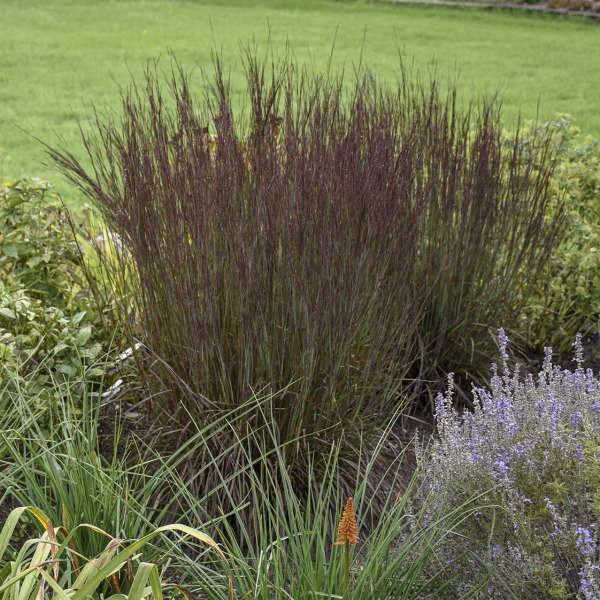
Smoke Signal Little Bluestem
Schizachyrium scoparium ‘Smoke Signal’
This native has a beautifully refined habit and puts forth a strong show of color in late summer and fall. The blue-green foliage begins to take on scarlet red tones in late summer, turning a deeper red-purple through the fall. Tiny, tan seed heads appear in early fall on the top half of the stems. Maintains its strictly upright habit through fall.
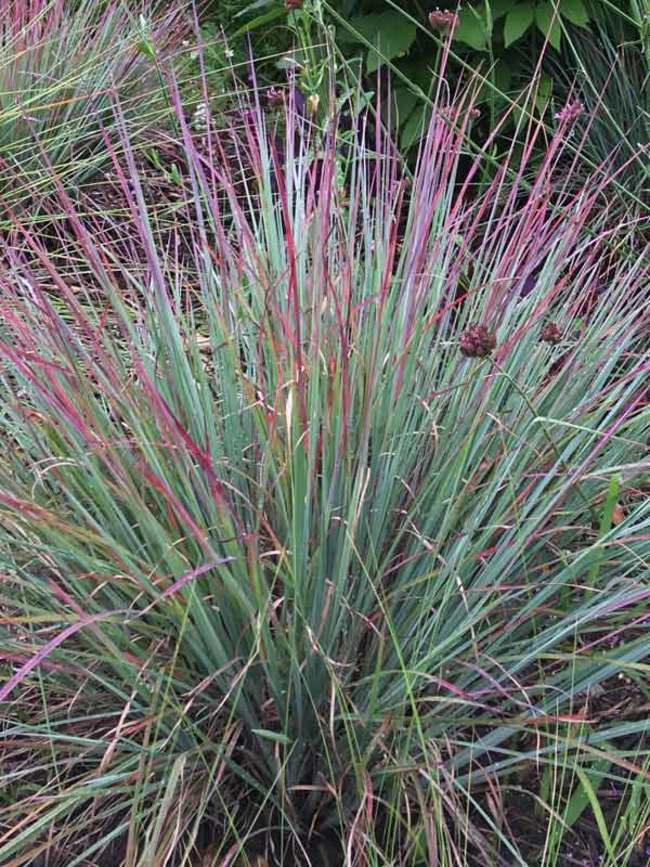
Standing Ovation Little Bluestem
Schizachyrium scoparium ‘Standing Ovation’
A cultivar which features blue leaf blades with red tips. The upright and rigid plant habit of this cultivar is typically retained without lodging when plants are grown in rich soils. It typically matures to 2-4’ (less frequently to 5’) tall. Purplish-bronze flowers appear in 3” long racemes on branched stems rising above the foliage in August. Flowers are followed by clusters of fluffy, silvery-white seed heads which are attractive and often persist into winter. Many consider the most outstanding ornamental feature of this grass to be its bronze-orange fall foliage color.
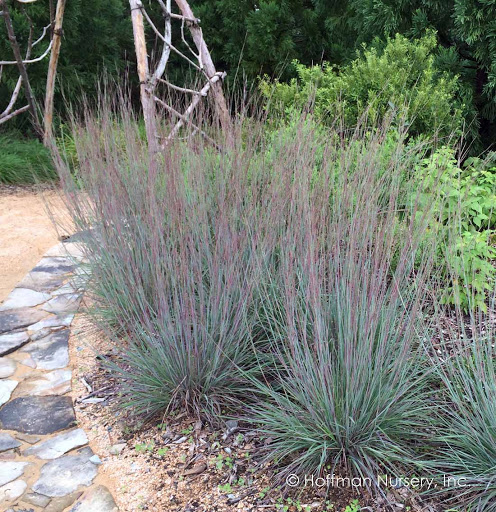
The Blues Little Bluestem
Schizachryrium scoparium ‘The Blues’
Outstanding eastern native meadow species. Clumping plants produce half-inch wide leaves on upright stems in a unique light blue coloring. Flowers in late summer with very erect fine textured needle-like spikes. In fall plants turn a showy coppery orange overall. Valuable plant for meadow and prairie gardens. Vital species for reclamation and conservation. Fast growth to 2 feet, 3 to 5 feet tall in bloom, spreading 2 feet wide.
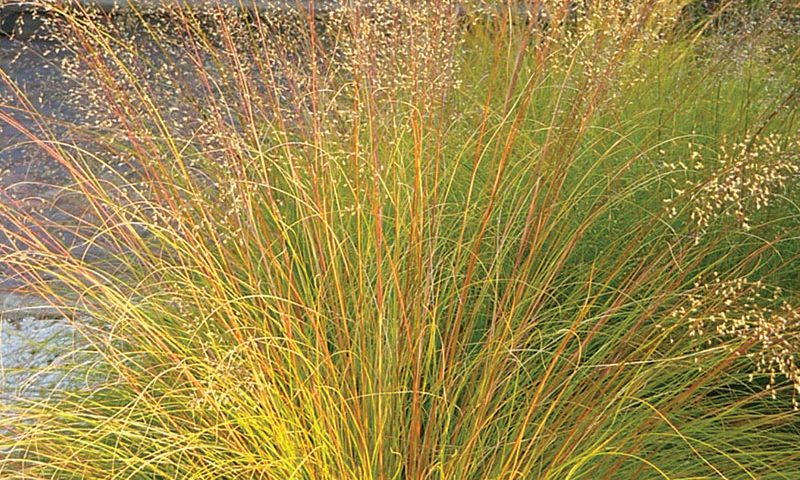
Prairie Dropseed
Sporobolus heterolepis
Missouri native perennial grass which typically occurs in prairies, glades, open ground and along railroads. Native from Quebec to Saskatchewan south to Colorado, Texas and Connecticut. Fine-textured, hair-like, medium green leaves typically form an arching foliage mound to 15” tall and 18” wide. Foliage turns golden with orange hues in fall, fading to light bronze in winter. Open, branching flower panicles appear on slender stems which rise well above the foliage clump in late summer to 30-36″ tall. Flowers have pink and brown tints, but are perhaps most noted for their unique fragrance (hints of coriander). Tiny rounded mature seeds drop to the ground from their hulls in autumn giving rise to the descriptive common name.
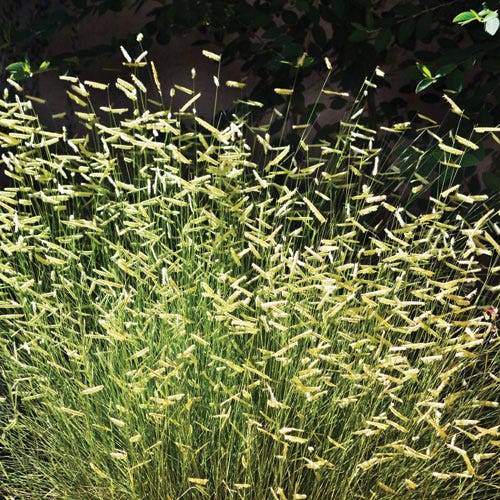
Blonde Ambition Blue Grama Grass
Bouteloua gracilis ‘Blonde Ambition’
Blonde Ambition’ produces chartreuse flowers (instead of purple for the species) on taller flowering stems that rise to 2 1/2′ tall. Chartreuse flowers contrast nicely with the blue-gray leaf blades. Flowers give way to blonde seed heads which typically remain through fall into early winter.
